| dc.contributor.advisor | Moldestad, Britt Margrethe Emilie | |
| dc.contributor.advisor | Madsen, Trine. A. | |
| dc.contributor.author | Smedsli, Madelen | |
| dc.date.accessioned | 2021-07-22T16:12:33Z | |
| dc.date.available | 2021-07-22T16:12:33Z | |
| dc.date.issued | 2021 | |
| dc.identifier | no.usn:wiseflow:2636125:43485484 | |
| dc.identifier.uri | https://hdl.handle.net/11250/2765116 | |
| dc.description.abstract | En plattform har ofte olje- og gassproduksjon fra mer enn ett felt. Bestemmelsen av hvor mye olje og gass som kommer fra de forskjellige feltene kalles allokering. Plattformen studert i denne rapporten heter Platform Vest, som ligger i Nordsjøen, med produksjon fra felt A, felt B (høy GOR) og felt C (lav GOR). Den nåværende allokeringsmetoden for Platform Vest er basert på oljeutvinningsfaktorer (ORF) for hver komponent. Andre evaluerte allokeringsmetoder er allokering by difference, prosessimulering og pro-rata allokering.
Hovedmålet for rapporten er å anbefale den mest rettferdige allokeringen for Platform Vest og for allokering generelt.
Målet for oppgaven studeres ved hjelp av forskjellige prosessimuleringer opprettet i UniSim og ProMax, med varierende fluidkarakteriseringer (hentet fra PVTsim) og forskjellige prosessinputparametere og oppsett.
Når man sammenligner de forskjellige allokeringsmetodene, var den nåværende etablerte ORF-metoden metoden som ga den mest rettferdige allokeringen av gass og olje til de forskjellige feltene, spesielt når man tok hensyn til de forskjellige GOR-verdiene i feltene.
Inkludering av aromater i fluidkarakteriseringen og benyttelse av ProMax-modellen ga det høyeste avviket fra det opprinnelige tilfellet når man sammenligner de estimerte ORFene. Begge disse metodene bør undersøkes nærmere for å avgjøre hvilken innvirkning dette kan ha på allokeringen.
Dette kan oppsummeres med at den nyeste fluidkarakteriseringen og oppdatert prosessinput (en prosessimulering vil aldri være mer nøyaktig enn nøyaktigheten av inputparameterne) alltid brukes når det er mulig. C20 + vurderingen og utility allokering i UniSim kan trygt benyttes for å estimere ORFene med omtrent samme resultat som det opprinnelige tilfellet. C10 + vurderingen kan vurderes for ORF-estimering uten for store avvik fra det opprinnelige tilfellet. | |
| dc.description.abstract | A platform often has oil and gas production from more than one field. The determination of how much oil and gas originates from the different fields is called allocation. The platform studied in this report is called Platform Vest, located in the North Sea, with production from field A, field B (high GOR) and field C (low GOR). The current allocation method for Platform Vest is based on oil recovery factors (ORF) for each component. Other allocation methods evaluated are allocation by difference, process simulation and pro-rata allocation.
The main objective for the report is to recommend the most fair and prudent allocation for Platform Vest and allocation in general.
The objective is studied using different process simulations created in UniSim and ProMax, with varying fluid characterisations (obtained from PVTsim) and different process input parameters and utilities.
When comparing the different allocation methods, the current established ORF method was the method that gave the fairest allocation of gas and oil to the different fields, especially when considering the different GOR values of the fields.
Inclusion of aromatics in the fluid characterisation and the case using the ProMax model gave the highest deviation from the initial case when comparing the estimated ORFs. Both cases should be investigated further to determine the impact this can have on the allocation.
In conclusion, the newest fluid characterisation and up-to-date process input (a process simulation will never be more accurate than the accuracy of the input parameters) should always be used when possible. The C20+ lumping and the allocation utility method can be safely used with the ORF estimation with approximately the same result as the initial case. The C10+ lumping scheme can be considered for ORF estimation without too large deviations from the initial case. | |
| dc.language | eng | |
| dc.publisher | University of South-Eastern Norway | |
| dc.title | Recommended guideline for allocation simulation | |
| dc.type | Master thesis | |
